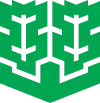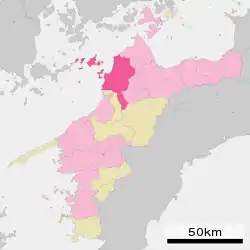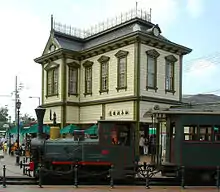Matsuyama
Matsuyama (松山市, Matsuyama-shi, Japanese: [matsɯꜜjama]) is the capital city of Ehime Prefecture on the island of Shikoku in Japan and also Shikoku's largest city, with a population of 509,835 as of June 1, 2019.[1] It is located on the northeastern portion of the Dōgo Plain. Its name means "pine mountain". The city was founded on December 15, 1889.
Matsuyama
松山市 | |||||||||
|---|---|---|---|---|---|---|---|---|---|
 From top left:Dōgo Onsen Honkan, Stone monument of Shiki Masaoka, Matsuyama Castle, Botchan train, The gate of Ishite-ji, Iyotetsu Matsuyama-shi Station, Gintengai Street | |||||||||
 Flag  Emblem | |||||||||
 Location of Matsuyama in Ehime Prefecture | |||||||||
 Matsuyama Location in Japan | |||||||||
| Coordinates: 33°50′N 132°46′E | |||||||||
| Country | Japan | ||||||||
| Region | Shikoku | ||||||||
| Prefecture | Ehime Prefecture | ||||||||
| First official recorded | 1 AD | ||||||||
| City Settled | December 15, 1889 | ||||||||
| Government | |||||||||
| • Mayor | Katsuhito Noshi (since December 2010) | ||||||||
| Area | |||||||||
| • Total | 429.40 km2 (165.79 sq mi) | ||||||||
| Population (June 1, 2019) | |||||||||
| • Total | 509,835 | ||||||||
| • Density | 1,200/km2 (3,100/sq mi) | ||||||||
| Time zone | UTC+09:00 (JST) | ||||||||
| City hall address | 4-7-2 Nibanchō, Matsuyama-shi, Ehime-ken 790-8571 | ||||||||
| Website | www | ||||||||
| |||||||||
The city is known for its hot springs (onsen), among the oldest in Japan, and is home to the Dōgo Onsen Honkan, a Meiji Period wooden public bathhouse dating from 1894.[2] A second favorite tourist spot is Matsuyama Castle. Eight of the eighty-eight temples in the Shikoku Pilgrimage are in Matsuyama.
History and culture
Matsuyama was in medieval times part of the Iyo-Matsuyama Domain, a fiefdom of Iyo Province consisting mainly of a castle town, supporting Matsuyama Castle. There was a nearby village at Dōgo Onsen to the east and a port somewhat farther to the west at Mitsuhama providing a link to the Japanese mainland (Honshū) and Kyūshū.
Dōgo Onsen was already famous in the Asuka period, as Shōtoku Taishi visited the spa in the year 596. It is also mentioned in passing in The Tale of Genji. The site of the former Yuzuki Castle is nearby.
Famous Buddhist temples in Matsuyama include Ishite-ji (石手寺), Taisan-ji (太山寺), and Jōdo-ji (浄土寺), all dating back to the 8th century, although the oldest surviving buildings are from the early 14th century, as well as Hōgon-ji (宝厳寺), Taihō-ji (大宝寺) and Enmyō-ji (円明寺). Famous shrines of the city include Isaniwa Jinja (伊佐爾波神社), built in 1667.
The haiku poet Masaoka Shiki lived in Matsuyama. His house, now known as the Shiki-do, and a museum, the Shiki Memorial Museum, are popular attractions, and the centerpieces of the city's claim as a center of the international haiku movement. Other famous haiku poets associated with Matsuyama include Kurita Chodō, whose Kōshin-an was visited by Kobayashi Issa, Shiki's followers, Takahama Kyoshi and Kawahigashi Hekigoto, and Taneda Santōka. Santoka's house, known as Isso-an, is also a tourist attraction and is periodically open to the public. The Matsuyama Declaration of 1999 proposed the formation of International Haiku Research Center, and the first Masaoka Shiki International Haiku Awards were given in 2000. Recipients have included Yves Bonnefoy (2000), Cor van den Heuvel (2002) and Gary Snyder (2004).
The famed novel Botchan by Natsume Sōseki is set in Matsuyama. As a result, there are numerous sites and locales named after the main character, including Botchan Stadium, the Botchan Ressha (an antique train that runs on the city's tramway), and Botchan dango.
Matsuyama also figures in several works by Shiba Ryōtarō, notably his popular novel, Saka no Ue no Kumo [Clouds Above the Hill] (1969). In anticipation of the upcoming NHK Taiga drama adaptation of Saka no Ue no Kumo, a Saka no Ue no Kumo Museum was established in 2007.
Matsuyama was also the setting of a 1907 novel about the Russo-Japanese War, As the Hague Ordains, by American writer Eliza Ruhamah Scidmore. Matsuyama figures in the novel because the city housed a camp for Russian prisoners during the war. A Russian cemetery commemorates this important episode in Matsuyama history. The Russo-Japanese War is also remembered in Matsuyama because of the contributions of two Japanese military leaders, the Akiyama brothers, Akiyama Saneyuki and Akiyama Yoshifuru, who were born in the city.
The city today
In the twentieth century, various mergers joined the castle town with neighboring Dōgo, Mitsuhama, and other townships, aided by urban sprawl, creating a seamless modern city that now ranks as the largest in Shikoku.
As of the most recent merger, on October 1, 2018, absorbing the city of Hōjō, and town of Nakajima (from the former Onsen District), the city had an estimated population of 510,963 and a population density of 1,196 persons per km². The total (merged) area is 429.40 km².
.JPG.webp)

_2.jpg.webp)
Matsuyama is home to several universities including Ehime University (part of the Japanese national university system) and several private colleges, including Matsuyama University and Matsuyama Shinonome College.
Matsuyama has several important museums. The Museum of Art, Ehime is the city's main art museum, its collections emphasizing the works of regional artists. The Shiki Memorial Museum is a museum that focuses on the life and work of Masaoka Shiki, with special attention to his contribution to haiku. The Saka no Ue no Kumo Museum features exhibits connected with the famous novel and television series. There is a Juzo Itami museum dedicated to the famous film director.
Famous products (meibutsu) of Matsuyama include tarts and Botchan dango. In the 17th century, the lord of Matsuyama castle Sadayuki Matsudaira (松平定行) introduced the process of tart-making, originally brought to Japan by the Portuguese, to Matsuyama. At first it was a Castella with jam. According to legend Sadayuki made some changes, such as adding red bean paste. Now there are many kinds and makers of tarts in Matsuyama; some add yuzu paste or chestnut to the red bean paste. In addition to tarts, Botchan dango is also a famous product of Matsuyama. Botchan dango was named after the famous novel Botchan by Natsume Sōseki. It consists of three bean paste beads of three flavors, matcha, egg, and red bean paste. Within the paste is contained mochi.
Matsuyama is the site of a number of festivals, including the Dogo Festival, held in the spring, the Matsuyama Festival, held in August, and the Fall Festival, held in October, which features battling mikoshi.
The city is represented in the J. League of football with its local club, Ehime FC. The Ehime Mandarin Pirates also represent the city in the baseball Shikoku Island League Plus.
Climate
Matsuyama has a humid subtropical climate (Köppen climate classification Cfa; Trewartha climate classification Cf) with hot summers and cool winters. Precipitation is significant throughout the year, and is heavier from April to July as well as in September.
| Climate data for Matsuyama (1981-2010, elevation 32.2 m (106 ft)) | |||||||||||||
|---|---|---|---|---|---|---|---|---|---|---|---|---|---|
| Month | Jan | Feb | Mar | Apr | May | Jun | Jul | Aug | Sep | Oct | Nov | Dec | Year |
| Record high °C (°F) | 24.4 (75.9) |
24.5 (76.1) |
27.5 (81.5) |
31.1 (88.0) |
31.2 (88.2) |
35.6 (96.1) |
37.0 (98.6) |
37.2 (99.0) |
36.0 (96.8) |
33.3 (91.9) |
28.0 (82.4) |
22.5 (72.5) |
37.0 (98.6) |
| Average high °C (°F) | 9.8 (49.6) |
10.6 (51.1) |
13.9 (57.0) |
19.0 (66.2) |
23.6 (74.5) |
26.8 (80.2) |
30.9 (87.6) |
32.1 (89.8) |
28.6 (83.5) |
23.3 (73.9) |
17.8 (64.0) |
12.6 (54.7) |
20.8 (69.4) |
| Daily mean °C (°F) | 6.0 (42.8) |
6.5 (43.7) |
9.5 (49.1) |
14.6 (58.3) |
19.0 (66.2) |
22.7 (72.9) |
26.9 (80.4) |
27.8 (82.0) |
24.3 (75.7) |
18.7 (65.7) |
13.3 (55.9) |
8.4 (47.1) |
16.5 (61.7) |
| Average low °C (°F) | 2.3 (36.1) |
2.5 (36.5) |
5.2 (41.4) |
10.0 (50.0) |
14.7 (58.5) |
19.1 (66.4) |
23.5 (74.3) |
24.2 (75.6) |
20.8 (69.4) |
14.5 (58.1) |
9.2 (48.6) |
4.5 (40.1) |
12.5 (54.5) |
| Record low °C (°F) | −7.0 (19.4) |
−8.3 (17.1) |
−6.3 (20.7) |
−2.6 (27.3) |
1.4 (34.5) |
5.7 (42.3) |
14.3 (57.7) |
15.6 (60.1) |
9.1 (48.4) |
−2.2 (28.0) |
−1.2 (29.8) |
−5.8 (21.6) |
−8.3 (17.1) |
| Average precipitation mm (inches) | 51.9 (2.04) |
65.6 (2.58) |
102.3 (4.03) |
107.8 (4.24) |
141.5 (5.57) |
223.6 (8.80) |
191.6 (7.54) |
89.6 (3.53) |
130.3 (5.13) |
96.7 (3.81) |
68.0 (2.68) |
46.0 (1.81) |
1,314.9 (51.77) |
| Average snowfall cm (inches) | 1 (0.4) |
1 (0.4) |
0 (0) |
0 (0) |
0 (0) |
0 (0) |
0 (0) |
0 (0) |
0 (0) |
0 (0) |
0 (0) |
0 (0) |
2 (0.8) |
| Mean monthly sunshine hours | 125.8 | 138.9 | 166.7 | 189.0 | 198.5 | 160.2 | 192.9 | 221.9 | 165.0 | 177.3 | 144.4 | 136.5 | 2,017.1 |
| Source 1: Japan Meteorological Agency[3] | |||||||||||||
| Source 2: Japan Meteorological Agency (1981 - 2010)[4] | |||||||||||||
Transport
Matsuyama has a well-developed transport network. It is connected to the Japanese national railway network by Matsuyama Station on the Yosan Line. It also has a network of suburban railways run by the Iyo Railway, which is centred on Matsuyama City Station. Iyo Railway also operates a system of trams and busses, which serve as the city's main modes of public transportation. Matsuyama is one of the few Japanese cities that did not do away with its original tram system, which has continually operated from 1887. Matsuyama Airport offers flights to Tokyo, Seoul, Shanghai, and various other cities. There is regular ferry service to Hiroshima and regular night ferries to Kobe, Kokurakita-ku, Kitakyūshū, and several other destinations. Also, a hydrofoil service exists between Hiroshima and a few other destinations.
Economy
Miura (boiler manufacturer), Iseki (tractor and engine equipment),[5] Hatada Ichiroku (Japanese style confectionery), Poem, a food processing division of Pom (Ehime Drink Company), and the retailing companies Fuji and Daiki all have their headquarters in Matsuyama.
Notable people
- Kenta Abe, baseball player
- Akiyama Saneyuki, admiral in the Imperial Japanese Navy
- Akiyama Yoshifuru, general in the Imperial Japanese Army
- Kotomi Aoki, manga artist
- Ryō Aono, snowboarder
- Sidney Gulick, missionary
- Harada Sanosuke, 10th unit captain of the Shinsengumi
- Tomoko Honda, announcer
- Ippen, Buddhist preacher
- Juzo Itami, film director
- Mansaku Itami, film director
- Masaru Kageura, baseball player
- Katō Yoshiaki, daimyō
- Kurita Chodō, haiku poet
- Chiaki Kusuhara, beach volleyball player
- Loveli, fashion model and television personality
- Alan Shirahama, performer, actor, and DJ
- Masaoka Shiki, poet
- Hideki Matsuyama, golfer
- Yōko Matsuyama, actress
- Yasuyuki Muneta, judoka
- Riki Nakaya, judoka
- Kenzaburō Ōe, writer
- Nathaniel Rosen, cellist
- Mika Saiki, beach volleyball player
- Koshiro Shimada, Figure Skater
- Hisui Sugiura, graphic designer
- Kyoshi Takahama, poet
- Makoto Tamada, motorcycle racer
- Tadao Tannaka, mathematician
- Taneda Santōka, haiku poet
- Toshirō Tomochika, football player and politician
- Reiko Tosa, athlete
- Tetsu Yano, writer
Sister cities
Matsuyama has three sister cities, as designated by Sister Cities International:
 Sacramento, California, United States
Sacramento, California, United States Freiburg, Baden-Württemberg, Germany
Freiburg, Baden-Württemberg, Germany Pyeongtaek, Gyeonggi, South Korea
Pyeongtaek, Gyeonggi, South Korea
See also
References
- "Matsuyama (City (-shi), Ehime) - Population Statistics and Locations in Maps and Charts". citypopulation.de. January 3, 2015. Retrieved October 25, 2015.
- http://www.japan-guide.com/e/e5502.html
- 松山 1981-2010年. Japan Meteorological Agency. Retrieved 2018-05-15.
- 松山 観測史上1~10位の値 (in Japanese). Japan Meteorological Agency. Retrieved 2018-05-15.
- "Company Outline." Iseki. Retrieved on March 31, 2018.
- ウリハッキョ一覧. Chongryon. Archived from the original on July 26, 2015. Retrieved October 14, 2015.().
External links
| Wikimedia Commons has media related to Matsuyama, Ehime. |
| Wikivoyage has a travel guide for Matsuyama. |
- Matsuyama City official website (in Japanese)
- Matsuyama City official website (in English)
- Sophia Club An NPO that creates a friendly environment for foreigners
- Matsuyama Declaration
- CityMayors.com city profile by Mayor Nakamura